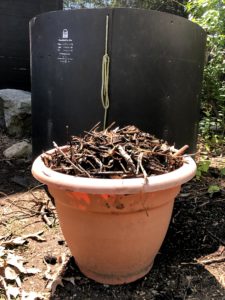For years I have told classes “If you put sticks in, you’ll need to pull sticks out,” and here’s an example of why: That’s a big bucket of sticks, raspberry canes and similar woody items I pulled from the finished 1 cubic yard compost bin behind it.
It is basically the same amount of sticks I put into the bin in the first place, meaning they were useless in the compost.
I ran this little experiment so you don’t have to, and because I’ve grown tired of the refrain that one should put sticks in compost, whether to increase aeration – as if those pores don’t get filled with other materials – or for other reasons.

What’s the point in adding sticks if the organisms do nothing with them anyway? They’re carbon-rich but if they’re not consumable then they’re wasted space and extra work.
The “no sticks” mantra holds true and here’s why: similar to peach pits and peanut shells that are slow to decompose, sticks are high in lignin and cellulose, and your home compost isn’t likely to be active long enough to break them down in a reasonable time frame.
The first round of organisms in your compost are the mesophylic organisms – they like moderate temperatures. They get the pile hot enough for the thermophylic or heat loving organisms, which take over. Once the thermophylic organisms are done, the mesophylic come back into action as the compost cools off or “cures.”
Here’s the thing though: In the initial heat up of the pile, amino acids are created that result in a temporary drop of the pile’s pH. That lower pH (acidic) environment is key for many fungi that dine on cellulose and break down sticks. However, that time is limited and the opportunity to break down woody items is limited by the duration of your compost bin. By the time your pile is finished, the pH has moved back toward neutral.
Now you can screen that woody material out at the end and then add it to the next batch of compost and keep doing that for pile after pile until the material finally breaks down. That’s fine, but it means you’re going to be screening the same sticks out several times, and for what purpose? If the organisms in your compost aren’t breaking the sticks down then what are they contributing to the pile? If the organisms aren’t consuming/converting them, then what are they doing there? And what happens when you’ve got an overabundance of woody material you’ve been screening from one pile to the next?
I know I’ve got better things to do than make extra work for myself and I imagine you do, too.
Locally, municipal compost facilities take all sorts of woody materials. They manage these in large windrows that are both tall and long, turned with specialized equipment, monitored for moisture and finally screened when finished. Before screening the finished compost, you can see all sorts of woody material present, from twigs to chopped up branches.
If their 8′ tall x 8′ wide x 100’+ rows aren’t breaking down sticks, why do you think your compost will?
If sending twigs to a municipal compost isn’t an option, then consider buying a small electric chipper and using the material as mulch or giving it to someone to use as kindling but for goodness sake, stop putting sticks in your compost.
UPDATE: You may also be interested in reading More about sticks in the compost.


